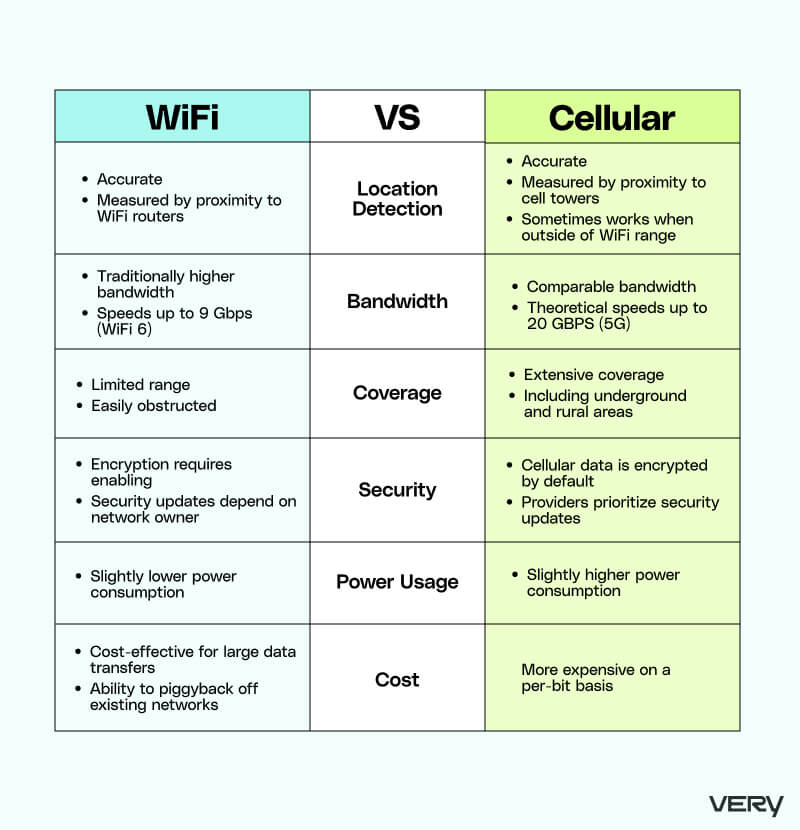Cellular vs. WiFi: Which is better for your IoT project?

Cellular vs. WiFi: Which is better for your IoT project?

As the name suggests, Internet of Things (IoT) devices require a stable and secure way to connect to the Internet to communicate and exchange data. However, the choice between WiFi vs. cellular connectivity isn't always clear-cut.
WiFi and cellular networks are the two most popular wireless technologies that make IoT networks possible—they provide the “I” in “IOT.” Although WiFi has been the main choice for IoT for many years, cellular networks have grown in popularity and are now a highly viable alternative.
In this article, we will discuss the pros and cons of WiFi and cellular IoT networks to help you decide which one to use for your next IoT project.
IoT wireless network
WiFi technology uses multiple frequency bands of radio waves to transmit information between devices.
In order to achieve a WiFi connection, a device must have a wireless adapter that converts data and radio signals. The device communicates with the adapter chip using protocols such as UART or SPI. The adapter then communicates with the external router, which sends this data to the Internet over a wired Ethernet connection.
The system's three components - the device, chip and router - must conform to the same WiFi standard, such as WiFi 7 or 802.11ax (also known as WiFi 6).
IoT Cellular Network
IoT devices using cellular technology connect to the internet using the same network as smartphones and other mobile devices. These devices are equipped with modems that communicate with the nearest cell tower, thereby facilitating the transfer of information. Use low-level communication protocols such as UART or SPI to control the modem.
LTE-M (Long Term Evolution for Machines) and NB-IoT (Narrowband IoT) are two popular cellular IoT technologies. LTE-M offers faster speeds and is compatible with existing LTE infrastructure, while NB-IoT requires cellular providers to upgrade their hardware, resulting in slower deployments. Additionally, NB-IoT offers wider coverage but requires devices to remain stationary.
WiFi vs. Cellular: IoT Features Comparison
This section takes a closer look at how WiFi and cellular networks overlap in different functional aspects of IoT devices.
cost
Cellular networks tend to be much more expensive than WiFi on a per-bit basis. Therefore, WiFi is a more preferable option when you plan to do heavy data transfers, such as regular security updates. Additionally, you can sometimes "piggyback" on an existing public or private WiFi network to save costs.
Security and privacy
Cellular networks have two major security advantages over WiFi:
Cellular data is encrypted by default, while WiFi connections must have encryption enabled.
Cellular security updates are handled by providers who have dedicated cybersecurity staff and prioritize security due to financial and reputational incentives. In contrast, WiFi security relies on individual WiFi network owners proactively installing updates.
While cellular networks generally adhere to higher security standards, a well-maintained private WiFi network can provide considerable security.
location detection
Both WiFi and cellular networks can provide accurate location information by measuring your distance from the nearest router or cell tower, respectively. In some cases, the cellular network may be able to determine your location when you are out of WiFi range.
Coverage
Cellular network coverage is extensive and continues to expand. Cellular IoT technologies such as LTE-M and NB-IoT provide deeper coverage than traditional cellular technologies, reaching places such as underground areas, metal buildings, and rural environments.
WiFi has limited range and is more likely to be blocked by obstacles. As a local area network (LAN), WiFi can provide strong coverage in a limited area close to the access point. However, once the device leaves the area, connectivity drops quickly. In other words, if the device is highly mobile or deployed in a remote location, WiFi is not the best choice.
bandwidth
WiFi and cellular networks now offer comparable maximum speeds, although achieving these speeds on cellular may be more expensive.
WiFi has traditionally outperformed cellular networks in terms of bandwidth, with older WiFi standards (802.11b/g/n) offering speeds of up to 450 megabits per second, and the newer WiFi 6 (802.11ax) standard offering speeds of up to 450 megabits per second. 9 gigabits.
Cellular technology based on the 5G standard can theoretically reach speeds of up to 20 Gbps, making cellular bandwidth comparable to WiFi. As mobile technology advances, cellular networks are sufficient for almost all IoT use cases.
WiFi does have one drawback: the more devices that try to access the network, the worse the WiFi signal becomes. This means that WiFi performs significantly worse in densely populated areas as devices compete for bandwidth. Cellular networks typically don't face this problem due to the technology's underlying protocols and hardware.
Electricity usage
Both cellular and WiFi technologies can consume significant power if not managed properly to conserve battery life. However, in general, WiFi usage may be less. Device manufacturers deal with these issues in two ways: either by putting the device to sleep and waking it up periodically, or by disabling the connection when not in use.

WiFi vs Cellular Network Diagram
WiFi vs. Cellular: Which Is Better for Your IoT Project?
As we've discussed, there are many factors and variables that can make this decision more complicated than it initially seems. Both techniques are used to solve different types of challenges, and neither technique has universal advantages.
While WiFi or cellular may be the obvious choice in some cases, business needs can complicate things. For example, deploying IoT devices in third-party retail stores that may not provide WiFi credentials may impact the decision.
You may even find yourself choosing not which technology to use, but which technology to use first. Many IoT products use both cellular and WiFi to provide backup in the event the primary technology fails.
For your IoT project, choosing WiFi or cellular will largely depend on the priorities of your device and its purpose. Ultimately, the decision will come down to trade-offs between power consumption, bandwidth, coverage, and security.